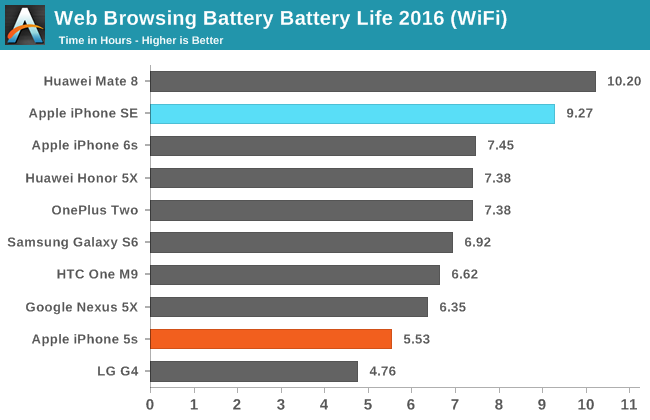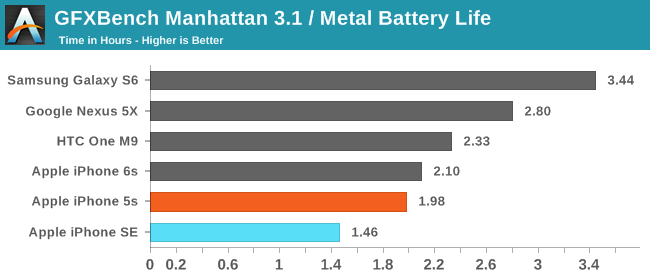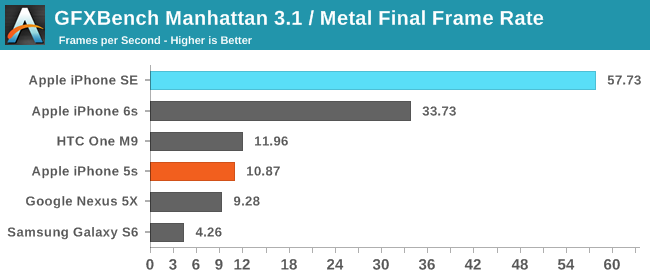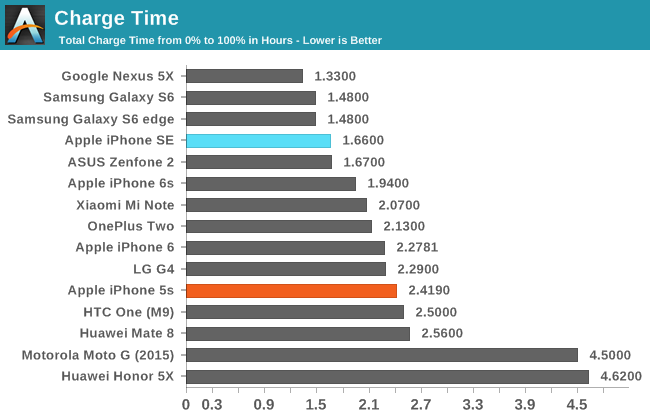The iPhone SE Review
by Brandon Chester on May 16, 2016 8:00 AM EST- Posted in
- Smartphones
- Apple
- Mobile
- iPhone
- iPhone SE
Battery Life
Our battery life tests have also been upgraded for 2016. Our web browsing test was previously shown in the first part of the Galaxy S7 review, and since that time it has been tweaked to the point that we're happy with the workload it puts on devices. We've also migrated to GFXBench's Manhattan test for examining battery life with a heavy GPU workload.

In our WiFi web browsing test the iPhone SE does quite well. When Apple originally advertised that the SE has better web browsing battery life than the 6s and 6s Plus I saw some confusion from many people, but it's actually not a surprising outcome. The SE is using a much smaller and lower resolution LCD display than the other iPhones, which significantly reduces the total platform power. The boost in battery capacity from the iPhone 5s helps as well. Apple advertises that the SE can last two hours longer on WiFi than the 6s, and in our test it almost meets that target.
Due to a recent move, I'm still trying to find a place with sufficient signal strength that I can use for LTE battery life testing. Until such a time, I'm unable to post LTE battery life results for the SE. In general you can expect LTE battery life to be a couple hours shorter than on WiFi, and Apple advertises that the SE can last three hours longer on LTE than the 6s, so if they get anywhere close to that then LTE battery life should be quite good.


The 4-inch iPhones have never lasted long in GFXBench's battery test. With the new Manhattan test the GPU is doing a lot more work than it was with T-Rex HD, and there aren't any periods of idle. The iPhone SE achieves the lowest battery lifetime of just 1.46 hours. However, the on screen frame rate during the test is hitting Vsync, which is actually concerning because we moved to Manhattan to avoid the problem of devices hitting that cap and then idling in the middle of the test. As I've said in the past, you need to consider both performance and battery life in this test. The iPhone SE is obviously an improvement over the 5s even though it dies half an hour earlier, because by the end of the test the iPhone SE is giving you 6x the performance of the 5s due to the A7 SoC's greater degree of thermal throttling.
Charge Time
Like the iPhone 6s and 6s Plus, the iPhone SE ships with Apple's 5W charging block. While this can be quite problematic on a large phone like the iPhone 6s Plus, on a small phone it won't pose as much of an issue as the phone's battery capacity is much lower. Ideally we'd like to see a time to charge that is under three hours, and coming in under two hours is even better.

The iPhone SE charges quite quickly. We've seen improvements to charge time on the iPhone since the era of the iPhone 5s, and with the SE having a smaller battery than the iPhone 6s it makes sense that the charge time would be shorter. I do wonder how long it would take to get to full charge if Apple bundled a 10-15W charger with the phone, although with the current time being under two hours you also need to consider if the potential reduction in battery longevity from quicker charging is worth it.










138 Comments
View All Comments
michael2k - Monday, May 16, 2016 - link
You're curious how much faster the iPhone SE is than the Galaxy S7? Just look for iPhone 6S and you'll see, given the SE uses the same SoC as the 6S:http://www.anandtech.com/show/10120/the-samsung-ga...
osxandwindows - Monday, May 16, 2016 - link
I can't wait for the "anandtech is so biased" comments to show up.Alexey291 - Monday, May 16, 2016 - link
Ah yes the first of the flame bait comment, so soon too...That said I did giggle at the excuse that he can't use non review data in a review. I'm pretty sure I've seen that happen far more than once. But yeah whatever. It's just a phone
extide - Tuesday, May 17, 2016 - link
That's not what he said. He said he can't use data that he doesnt have.xmrv - Sunday, May 22, 2016 - link
sheeps dont do that so you wont see any comments like that on this site...DesertCat - Monday, May 16, 2016 - link
Thanks for the article. I have some friends wanting to stick with the smaller form factor and will forward your review along.One quibble from the Experience page: "X fewer emails in the Mail app"
I'm guessing that was a place holder waiting for you to update with the number after you looked it up. May want to get that edit in. ;)
MonkeyPaw - Monday, May 16, 2016 - link
It's a little bit of a lazy effort from Apple, but it should still be a crowd pleaser. The issue is that you can get a much bigger display in the footprint of the SE. I believe the Xperia Compact is almost the same size as the SE, but can offer a 4.6" display instead. That big thumb button is really costly on Apple devices.Aenean144 - Monday, May 16, 2016 - link
No, it really isn't. The Touch ID home button has been a huge advantage, well worth the costs of poorer screen-to-body ratios. Maybe in the future the button goes away, but it has served Apple and Samsung quite well.iPhone 5/5S/SE
dimensions: 12.4 x 5.9 x 0.76 cm
footprint: 73.2 cm^2
volume: 55.6 cm^3
Xperia Z5 compact
dimensions: 12.7 x 6.5 x 0.89 cm
footprint: 82.6 cm^2
volume: 73.5 cm^3
Xperia Z3 Compact
dimensions: 12.7 x 6.5 x 0.86 cm
footprint: 82.6 cm^2
volume: 71.0 cm^3
iPhone 6
dimensions: 13.8 x 6.7 x 0.69 cm
footprint: 92.5 cm^2
volume: 59.2 cm^3
iPhone 6S
dimensions: 13.8 x 6.7 x 0.71 cm
footprint: 92.5 cm^2
volume: 60.9 cm^3
The footprint of the Xperia "Compacts" are indeed small, but both the iPhone 5 and 6 models are smaller then them in there own ways. 5/5S/SE are smaller by 10% in footprint and 25% in volume. The iPhone 6/6S have smaller volumes by 15%.
An iPhone SE will definitely feel smaller than the Xperia Compacts, while the 6/6S may feel smaller then them depending on users favoring the thinnes. The Xperias also have onscreen home, back, multitasking keys, so that 4.6" has something like 4.2" of application space for many apps.
mooncancook - Monday, May 16, 2016 - link
Partially true regarding onscreen home/back keys. On lots of apps they auto hide so the app can use the entire screen, and you swipe that area to bring the keys up.ianmills - Monday, May 16, 2016 - link
Chinese phones put the touch ID just under the camera lense. It works great (at least on bigger phones) because thats where your finger naturally rests